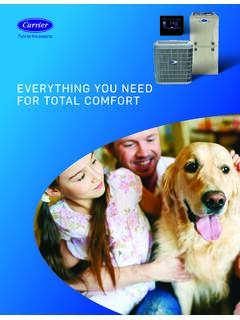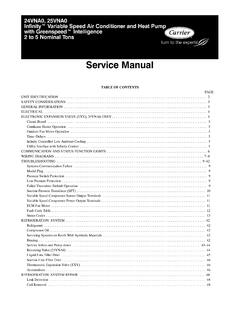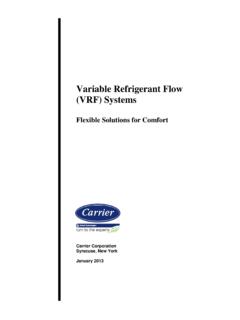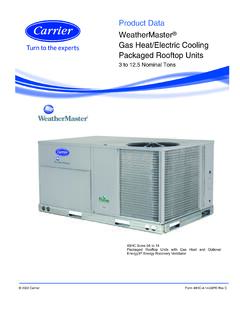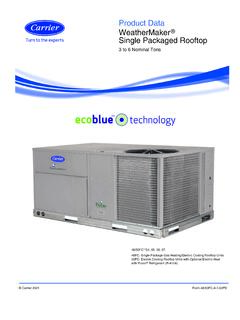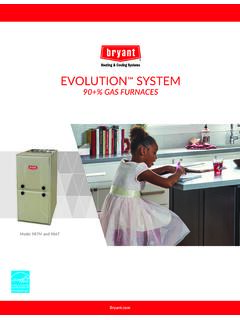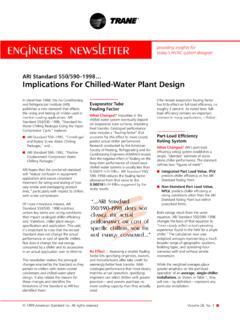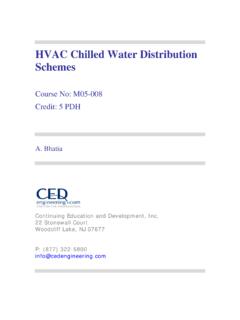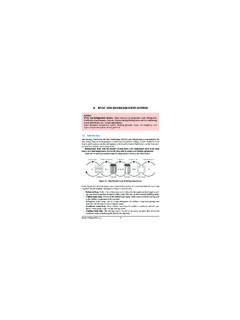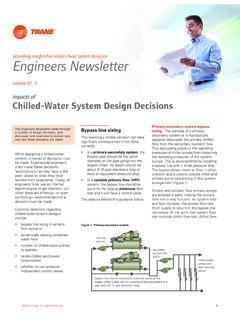Transcription of HEAT RECOVERY FROM CHILLED WATER SYSTEMS
1 HEAT RECOVERY FROM CHILLED WATER SYSTEMS Applications for Heat Reclaim Chillers April 2022 3 TABLE OF CONTENTS INTRODUCTION .. 3 WASTE HEAT SOURCES .. 3,4 Capturing Sufficient Heat for Useful Purposes .. 3 HOT WATER SYSTEMS .. 5,6 Building Heating .. 5 Service WATER Heating .. 6 Process Hot WATER .. 6 IS HEAT RECOVERY REQUIRED? .. 7 ASHRAE .. 7 MINIMIZING CHILLER LIFT WILL MAXIMIZE CHILLER EFFICIENCY .. 8,9 SAVING WASTED HEAT FOR USEFUL PURPOSES .. 10,11 HEAT RECLAIM CHILLER FUNDAMENTALS .. 12,13 The Heat Reclaim Chiller .. 12 Single Bundle Heat Reclaim Chiller .. 12 Double Wall Vented Heat Reclaim Chiller .. 12 Double Bundle Heat Reclaim Chiller with Full Condensing Heat Exchanger.
2 13 Hot WATER Temperature Control .. 13 CHILLER PLANT APPLICATIONS FOR HEAT 14-16 Primary/Secondary CHILLED WATER System with Heat RECOVERY 14 Variable Primary Flow CHILLED WATER System with Heat RECOVERY Chiller .. 15 Series Counterflow CHILLED WATER System with Heat RECOVERY 16 USING THE CAPTURED HEAT .. 17 Ensuring Hot WATER is Available .. 17 CONCLUSIONS .. 18 INTRODUCTION Is it possible to save energy by using waste heat from a CHILLED WATER system? The answer to this question is certainly yes the process is known as Heat RECOVERY . This paper examines several heat RECOVERY methods of capturing heat from the CHILLED WATER system. This heat, which is otherwise wasted to the environment, can be used for many purposes, including building heat, service WATER heating and process heat applications.
3 To maximize the captured waste heat without decreasing the chiller plant efficiency, the system must accomplish the following: Capture sufficient heat for useful purposes Minimize chiller lift and maximize chiller efficiency Control the hot WATER temperature without sacrificing stable chiller plant operation These accomplishments can lead to reduced energy consumption, lower greenhouse gas generation, and lower carbon footprint. WASTE HEAT SOURCES Capturing Sufficient Heat for Useful Purposes Air-conditioning SYSTEMS transfer heat from one location to another through work that typically consumes electricity. Heat is drawn into the system to provide indoor cooling while heat leaves the system in the form of wasted heat at the condenser (Fig.)
4 1.) The amount of wasted heat can be 25% more than the cooling that the process creates. Fig. 1. Heat and Work Relationship in an Air-Conditioning System 4 The ability to capture and use this waste heat is known as heat RECOVERY , since the waste heat is recovered and used for other purposes, including heating hot WATER . Although this process is not new, the benefits of heat RECOVERY are even greater today. The use of heat RECOVERY to generate hot WATER can reduce the total energy needs of a building. To determine the potential to use this waste heat, the system efficiencies must be understood. A measure of an air conditioning system s efficiency is known as the Coefficient of Performance, or COP.
5 The COP for a system that produces heat is the ratio of the output heat to the supplied work as shown in Equation 1. In this equation, Q is the useful heat and W is the work consumed. The work comes from electricity consumed by the compressor. However, a heat RECOVERY system not only produces heat, it also produces cooling. Instead of the traditional air conditioning system, consider a system that produces hot WATER and the additional benefit of CHILLED , cold WATER . So, the COP equation to measure efficiency of producing CHILLED WATER can be expressed as shown in Equation 3. Equation 3 Coefficient of Performance for Cooling Equation 1 Coefficient of Performance From Fig. 1, consider how this system might be used for heat RECOVERY .
6 When capturing the Heat Out for a useful purpose, the COP equation would be represented by Equation 2. Equation 2 Coefficient of Performance for Heating But with heat RECOVERY SYSTEMS , the benefit of hot and cold WATER can be realized. So, the equation that quantifies the combined benefit of hot and cold WATER can be expressed as shown in Equation 4. Equation 4 Total COP for Heat RECOVERY + CHILLED WATER This combined efficiency can contribute to reducing the whole building energy consumption. SYSTEMS that generate sufficient useful heat for both heating and cooling purposes are entirely possible. In fact, heat RECOVERY SYSTEMS can generate hot and CHILLED WATER simultaneously for use within the building or for process applications.
7 5 HOT WATER SYSTEMS How can the recovered heat be used? Heat from hot WATER can be used for many purposes in the building or for process applications. In particular, hot WATER can be used for heating the building, heating service WATER or as part of a manufacturing or industrial process. There are many examples of each of these heating needs. However, before the appropriate system is considered for these needs, certain design criteria should be understood for each of these applications. Keep in mind that ASHRAE requirements for building heat and service hot WATER differ, so a thorough understanding of the standard is essential prior to designing the system. Building Heating Heating within the building can be achieved in many different ways, from radiant heating sources or reheat to hot WATER coils installed as part of an air-handling system, and many other means in between.
8 Most importantly, the hot WATER temperature, flow (in gallons per minute or GPM) and capacity (expressed in Btu/hr) must be fully understood in light of the dynamic heat transfer effects that the building will experience throughout the year. Fluctuations in outdoor temperature; the ever-changing loads from solar gains caused by the sun and internal heat sources such as lights, office equipment, and people; and the all important load from ventilation air must be understood and appropriately considered. Load estimating programs that evaluate the building s thermal performance throughout the entire year can help the system designer better understand the thermal dynamic forces influencing the heating needs.
9 A program such as Carrier s Hourly Analysis Program (HAP) can help evaluate the heating load from an HVAC system perspective [1] (Fig. 2). Understanding the appropriate hot WATER temperature needs for building heating purposes is important. Most reheat and building heat applications do not need 130 to 140 F to perform satisfactorily. As discussed later in this paper, operating the reclaim chiller at higher leaving condenser WATER temperature (LCWT) increases lift and reduces chiller plant efficiency. According to the 2020 ASHRAE SYSTEMS and Equipment Handbook, Applied Heat Pump and Heat RECOVERY SYSTEMS , Chapter 9. "For typical buildings, chillers normally provide hot WATER for space heating at 105 to 110 F ( to C).
10 " In many VAV (variable air volume) reheat applications, 105 F hot WATER can be used very effectively by simply specifying a 2-row reheat coil instead of a 1-row coil. So, elevated hot WATER temperatures may not be necessary for building heating applications. Lower temperatures will maximize chiller plant efficiency while minimizing system energy consumption. To further understand the building heating load requirements and the potential for a heat RECOVERY system, the monthly or even hourly heating loads should be considered. Figure 3 shows a typical hot WATER boiler plant load for an office building in Chicago. This information is necessary to determine when heating and cooling loads occur.


